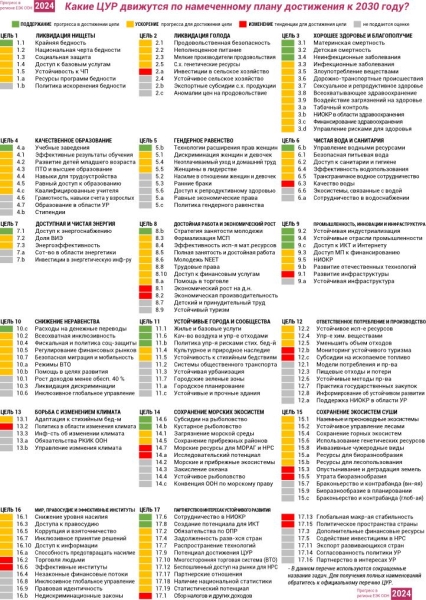
Pastures in remote mountainous areas of Kyrgyzstan. Crises are slowing the pace of sustainable development in Europe, North America and Central Asia Sustainable Development Goals
Efforts to achieve the Sustainable Development Goals (SDGs) by 2030 face serious obstacles due to the effects of the COVID-19 pandemic, shocks caused by climate change and the war against Ukraine, high interest rates and persistently significant inflation. This is stated in a new report from the United Nations Economic Commission for Europe (UNECE).
Impact of crises
New data collected for this year’s SDG progress report in the UNECE region reveals more fully the negative impact of these crises on prospects for achieving the SDGs. The region, covering Europe, North America, the Caucasus and Central Asia, Turkey and Israel, is on track to achieve only 20 targets (17 percent of 117 measurable targets) by 2030. This is down from 21 targets in 2023 and 26 in 2022.

Progress towards the SDGs
For 80 indicators (up from 79 last year), progress needs to be accelerated, and for 17 (up from 15 last year), current trends need to be reversed.
Alarm signals intensify
“The alarm bells are getting louder as we approach 2030, as this year’s SDG report unfortunately demonstrates,” said UNECE Executive Secretary Tatiana Molchan. “Given the second year of the war against Ukraine and the number of crises facing the region, the data for which have not yet been reflected, it is necessary to redouble efforts to restore the process of sustainable development to previous levels.”
The upcoming Futures Summit in September 2024 represents a global opportunity to improve the conditions for accelerating achievement of the SDGs, she said.
The fifth UNECE report on progress towards achieving the SDGs will be the main document that will inform discussions at the upcoming Regional Forum on Sustainable Development (13-14 March).
Fighting Poverty
The share of people living in poverty is falling in most countries, but not fast enough . In one third of countries for which data are available, more than 20 percent of the population still lives below the national poverty line.
One in 10 people live below 50 percent of their country’s median income – although this rate is falling in two thirds of countries, progress needs to accelerate. Extreme poverty, as defined internationally ($2.15 a day), remains rare in the region.
Those most at risk of poverty, such as people with disabilities and families with small children, in the UNECE region have access to a high level of social protection, but not everyone who could benefit from this type of support receives it. Less than half of the region’s unemployed receive cash unemployment benefits.
Housing, basic services, gender equality
The region is meeting targets for access to adequate housing and basic services, and in particular the proportion of the urban population living in slums has declined significantly in all countries for which data are available. Progress on gender equality can only be measured by less than half of the indicators.

The difference in time spent by women and men on housework and care is decreasing, but at a slower pace than desired. The share of women participating in political and economic life is rising in almost all countries in the region, but if current trends continue, by 2030 women will continue to be underrepresented in leadership and decision-making positions.
Inequality among students slows progress towards universal and quality education. Despite achieving gender parity in reading and mathematics, significant disparities still exist between urban and rural residents, natives and immigrants, and between advantaged and disadvantaged students.
Schools are well equipped, and most countries already provide universal access to computers, the Internet and other basic services in educational institutions. However, the proportion of youth and adults with information and communications technology (ICT) skills is increasing slowly. Also, since 2015, the participation of women and men of working age in education and vocational training has been growing at a slow pace.

Progress towards the SDGs
Health, well-being and nutrition
The region plans to achieve targets to reduce child and maternal mortality, as well as mortality from mental and non-communicable diseases.
Tobacco smoking prevalence is declining in almost all countries, but a quarter of all people aged 15 years and over in the region still use tobacco.
Progress in sexual and reproductive health remains poor. One in four women in the UNECE region still has unmet needs for modern family planning methods.
The proportion of the child population receiving recommended vaccinations is high, but the region will not be able to achieve universal access by 2030.
Although access to safe sanitation services is increasing, the current rate of improvement is not sufficient to achieve universal use by 2030.
Health coverage is gradually improving, but households are spending an increasing share of their income on health care. The pandemic has exposed gaps in access and strained public health capacity.
There is no universal access to sufficient nutritious food in the UNECE region. In a third of countries, more than 10 percent of adults are food insecure. Malnutrition among young children is rare.
Progress has been made in preserving the diversity and nutrition of food for future generations, and the number of animal breeds and plant varieties for which genetic materials are stored is increasing. However, the trend towards an increasing proportion of endangered native species needs to be reversed. Government spending on agriculture continues to decline.
Energy and climate
Electricity is available to almost everyone, and almost all residents of the region use environmentally friendly fuel sources for cooking, heating and lighting. More than three-quarters of countries are increasingly using renewable energy, and energy efficiency is improving almost everywhere. However, greater efforts are required to ensure continued access to affordable, clean energy.

Fossil fuel subsidies are increasing in many countries, making it difficult to meet greenhouse gas emission reduction targets by 2030.
To create a sustainable and viable infrastructure, it is necessary to reverse the downward trend in the share of passenger and freight transport by rail.
There is also an active reduction in the carbon intensity of economic production.
National and local governments have developed comprehensive natural disaster risk reduction strategies. The economic consequences of disasters are becoming less serious, but the number of victims continues to grow.
Water and environment
Access to safe drinking water is widespread, with access rates exceeding 99 percent of the population in 20 countries, but progress is slowing, putting the achievement of universal access by 2030 at risk.
The share of safely treated domestic wastewater is falling in more than half of the countries.
Water use in the region is becoming more efficient and pressure on freshwater resources is decreasing, but acceleration is required to achieve the 2030 targets. Transboundary water cooperation is widespread, but the pace of implementation of integrated water resources management must be accelerated.
In addition, progress in reducing marine pollution and preserving coastal areas needs to be accelerated. The region must change current trends to achieve targets for sustainable fisheries and marine technology research and development.
Progress towards sustainable forest management continues: Forest area is increasing in most countries, but not at a rate sufficient to meet the 2030 targets.
Protection of biological diversity on land and in freshwater areas, as well as in mountain ecosystems, needs to be improved, and measures must be taken to ensure equitable sharing of benefits and access to genetic resources. In addition, it is necessary to reduce the impact of invasive species and provide government assistance to developing countries in the conservation and sustainable use of biodiversity.
City air pollution is rapidly declining in almost all countries. The region must accelerate progress in the sustainable use of natural resources and waste reduction and recycling, the report’s authors note.
Economy and industry
The pace of economic recovery from the pandemic and growth in GDP per capita and per employee have slowed in the region. Unemployment levels have fallen in almost all countries, but the rate of decline needs to be accelerated, experts say.
Macroeconomic stability deteriorated and the share of budgets financed by domestic taxes fell in 2020 in almost all countries for which data are available. To achieve current indicators, it is necessary to change current trends.
The region has made significant strides in inclusive and sustainable industrialization, and access to information and communications technology is widespread. Both goals are on track to be achieved by 2030.
Peace and partnership for sustainable development
Countries in the region are becoming increasingly safer, with relatively few murders and fewer robberies. However, a quarter of people in countries for which data are available still feel unsafe walking alone at night, and overall progress in reducing violence has been too slow.
New data shows an increase in the prevalence of bribery in most countries that provide such information. In addition, to eradicate human trafficking and strengthen government institutions, it is necessary to change current trends, the report’s authors note.
Progress in ensuring access to justice is mixed. The rate of robberies reported to police is improving slightly, while two thirds of countries are seeing an increase in the proportion of pre-sentence incarcerated people in their prison population.
Decision-making bodies are increasingly reflecting the interests of the population, but the process needs to be accelerated to achieve proportional representation of women and youth in parliaments and the judiciary by 2030.
Progress on aid to least developed countries, technology transfer, more open trade, and improved market access for developing countries has been slow.
Data availability for SDG monitoring is improving. The number of global indicators that cannot be assessed in the UNECE region due to insufficient country data availability has decreased from 77 in 2023 to 71 in this assessment. The region needs to increase investment in statistical capacity.
Working on the report
Data collected in 2020 or later reflect trends since the start of the COVID- 19 for 143 of the 160 indicators used in this year’s assessment. Data for 2022 are already available for 44 indicators, so the impact of the first year of the war against Ukraine is partially reflected in the analysis. More detailed information about the data can be found in the SDG dashboard (above).
The analysis, which compares the 2030 indicator estimates with the indicator targets, uses the same methodology used in previous reports and assessments of the five UN regional commissions.
